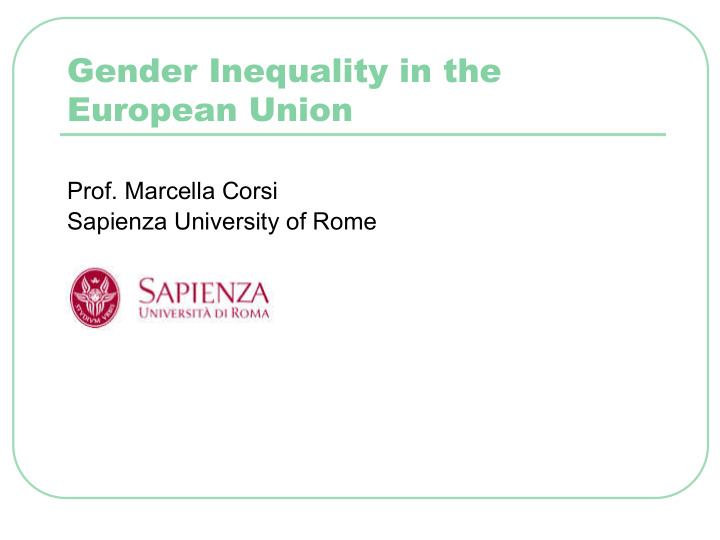



Gender Inequality in the European Union Prof. Marcella Corsi Sapienza University of Rome
Foreword l Growing inequality of income and wealth has become a major global concern. In many countries inequality has been driven by weak earnings growth not only among the poor but also among groups across much of the income distribution. l A clear but often overlooked feature of this discussion is that men and women are affected by the growing inequality in different ways.
Foreword l One reason it is overlooked is that income and wealth inequality are measured at the household level. But one person in the household typically earns and controls the money, and that person is almost always a man. l The concentration of income and wealth in the hands of men should reinforce the call to undertake greater redistributive policies.
Three different (complementary) views l Household and functional income distribution in light of gender inequality (during the crisis) l Individualized measure of poverty, to highlight gender differences (in recent years) l Issue of equal pay for equal work (enduring gendered inequalities in the labour market)
Household and functional income distribution l Empirical investigation carried out on the European Union Statistics on Income and Living Conditions (EU-SILC) database, covering 1,203,567 households in 27 EU countries for six years (from 2008 to 2013). l Major differences in terms of income exist between men-headed and women-headed households, namely the latter register on average a lower amount of wage, capital, labour income and State transfers over the entire period. These differences are evident over the entire period consolidating the income gap existing between households.
Changes in income by gender (EU EU, 2007-2012, %) 11 9 7 5 3 1 -1 Men hh Women hh -3 -5 -7 -9 -11 Labor income Capital State transfers -13 -15
Individualized measure of poverty l Structural gender inequality (and the associated need to consider individualized rather than household incomes) seems relevant in shaping gendered poverty and financial dependency in the EU. l Two measures of poverty: the at-risk-of-poverty rate (ARPR), considering individuals’ access to goods and services; and the financial dependency rate (FDR), considering individuals’ control over the household’s resources. Estimating these measures for the period 2007-2012 it can be shown that the gender gap in poverty is considerably higher in Europe than what is often assumed by policymakers.
Men’ en’s and and women’ omen’s pov pover erty and and financial inancial dependency dependency rat ates es (EU, U, 2007-2012, 2007-2012, %) %) 45% 40% 35% 30% 25% 20% 15% 10% 5% 0% 2007 2008 2009 2010 2011 2012 ARPR W ARPR M FDR W FDR M
Equal pay for equal work l The issue of equal pay for equal work captures the enduring gendered inequalities that exist on the labour market. l The case for taking action on unequal pay is important for women as individuals for equity reasons, for the economic well-being of their children and families, but also for society at large since an improvement of the position of women in the labour market – including pay equality – is crucial for economic growth.
Measuring Gender Gaps in Pay l The evaluation of the gender pay gap (GPG) and the gender gap in pension (GGP) in the EU needs suitable comparable data. l Most studies rely on the Structure of Earnings Survey (SES) to measure GPG. l We estimate GPG and GGP relying on the European Statistics on Income and Living Conditions (EU-SILC), which provides a wide range of information at individual level ensuring comparability across countries.
Gender Pay Gap and Gender Pension Gap over time (EU, 2006-2012, %)
Going deep Factors impacting on unequal pay : the employment structure in terms of educational attainments (share of women and men with secondary and tertiary education), occupational structure by macro sectors (industry, services and public administration), professional groups (share of women working as managers), hours worked (share of women working part time) and labour supply factors such as the share of foreign women (extra EU) in employment.
Main results l Increasing shares of female employees with secondary and tertiary education push up GPG because major differentials in pay are experienced for high skilled workers and best paid jobs. l Sectorial employment structure has a major effect on GGP in fact increasing shares of men employed in education, health and public administration (typically “female-oriented” sectors), decrease the gender gap in pensions. By contrast, a higher proportion of female workers in services drives up GGP.
Main results l An increase in the proportion of women working part-time pushes up the pension gap, while an higher share of male part-time workers positively impacts on pay gaps. l Institutional factors matter. • Major pay differentials are detected in those countries characterised by a higher segregation in terms of care activities, which is also reflected in terms of pension gaps. • A worsening position at country level in terms of women’s economic power increases GPG. • The existence of a legislation on minimum wage positively impacts on GPG, indirectly increasing women inactivity in the labour market.
To know more l M. Corsi (2015), “Equal Pay and Pension Gap” in European Parliament (2015), Gender Equality in Employment and Occupation - Directive 2006/54/EC European Implementation Assessment, DG for Impact Assessment and European Added Value, PE 547.546. l V. Cirillo, M. Corsi, C. D’Ippoliti (2015), “Gender, Class and the Crisis”, CEB Working Papers , n. 15-026, Université Libre de Bruxelles. l F. Botti, M. Corsi, C. D’Ippoliti, “Gendered Nature of Poverty in the EU: Individualized versus Collective Poverty Measure”, Feminist economics, forthcoming.
Recommend
More recommend